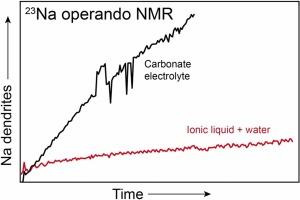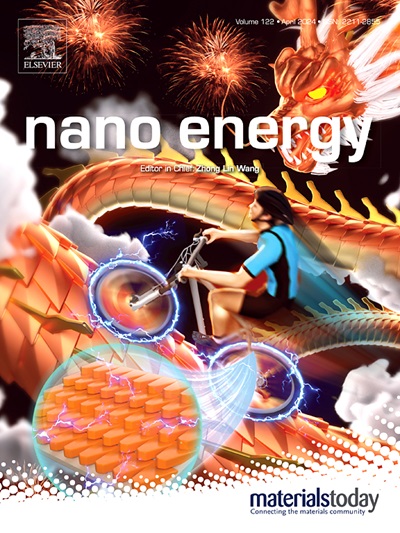Studying the growth and morphology of metal microstructures in sodium metal batteries with ionic liquid electrolytes by operando 23Na NMR spectroscopy
IF 16.8
1区 材料科学
Q1 CHEMISTRY, PHYSICAL
引用次数: 0
Abstract
Sodium metal batteries are a potentially promising energy storage solution due to the abundance and low cost of sodium and high energy density of metal anodes. However, the growth of microstructural metal during cycling remains a crucial safety and performance issue to be addressed. Herein we investigate this process in sodium metal symmetric cells using operando 23Na nuclear magnetic resonance spectroscopy. We analyse the NMR signal arising from the microstructural sodium metal to obtain quantitative and qualitative information on its growth and morphology, observing significant differences in the evolution of the microstructures for different electrolytes, including ionic liquids with different sodium salt concentrations, water as an additive, and comparing with a more traditional organic electrolyte. The results correlate well with the previously reported cycling performance of these electrolytes, as well as ex situ SEM images of the electrode surface after cycling.

通过操作性 23Na NMR 光谱研究离子液体电解质钠金属电池中金属微结构的生长和形态
钠金属电池是一种具有潜在前景的储能解决方案,因为钠资源丰富、成本低廉,而且金属阳极的能量密度高。然而,循环过程中微结构金属的生长仍然是一个亟待解决的重要安全和性能问题。在此,我们利用操作中 23Na 核磁共振波谱研究钠金属对称电池中的这一过程。我们分析了微结构金属钠产生的核磁共振信号,以获得有关其生长和形态的定量和定性信息,观察到不同电解质(包括不同钠盐浓度的离子液体、作为添加剂的水)在微结构演变方面的显著差异,并与更传统的有机电解质进行了比较。研究结果与之前报道的这些电解质的循环性能以及循环后电极表面的原位 SEM 图像密切相关。
本文章由计算机程序翻译,如有差异,请以英文原文为准。
求助全文
约1分钟内获得全文
求助全文
来源期刊

Nano Energy
CHEMISTRY, PHYSICAL-NANOSCIENCE & NANOTECHNOLOGY
CiteScore
30.30
自引率
7.40%
发文量
1207
审稿时长
23 days
期刊介绍:
Nano Energy is a multidisciplinary, rapid-publication forum of original peer-reviewed contributions on the science and engineering of nanomaterials and nanodevices used in all forms of energy harvesting, conversion, storage, utilization and policy. Through its mixture of articles, reviews, communications, research news, and information on key developments, Nano Energy provides a comprehensive coverage of this exciting and dynamic field which joins nanoscience and nanotechnology with energy science. The journal is relevant to all those who are interested in nanomaterials solutions to the energy problem.
Nano Energy publishes original experimental and theoretical research on all aspects of energy-related research which utilizes nanomaterials and nanotechnology. Manuscripts of four types are considered: review articles which inform readers of the latest research and advances in energy science; rapid communications which feature exciting research breakthroughs in the field; full-length articles which report comprehensive research developments; and news and opinions which comment on topical issues or express views on the developments in related fields.
 求助内容:
求助内容: 应助结果提醒方式:
应助结果提醒方式:


